C语言栈的各种基本运算代码
- 格式:doc
- 大小:33.00 KB
- 文档页数:3
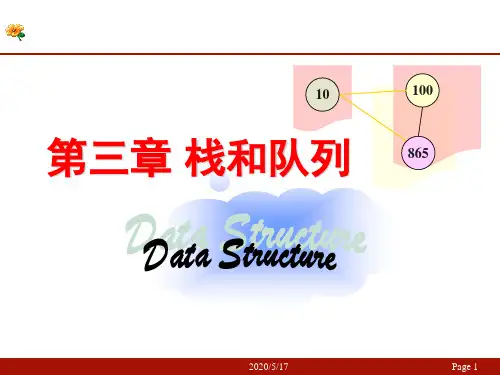
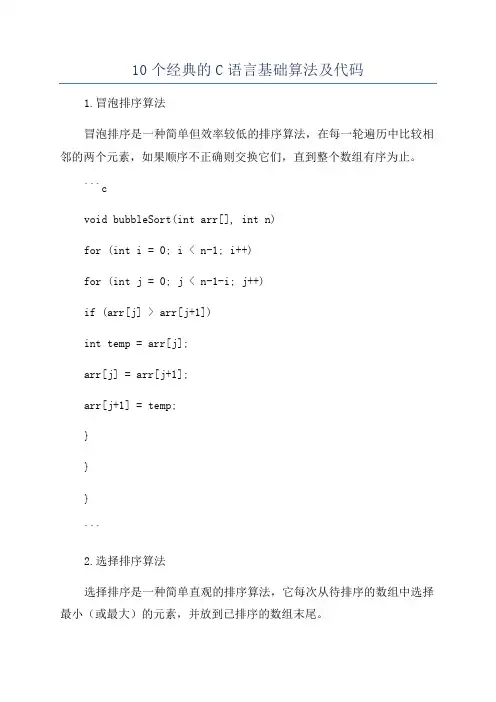
10个经典的C语言基础算法及代码1.冒泡排序算法冒泡排序是一种简单但效率较低的排序算法,在每一轮遍历中比较相邻的两个元素,如果顺序不正确则交换它们,直到整个数组有序为止。
```cvoid bubbleSort(int arr[], int n)for (int i = 0; i < n-1; i++)for (int j = 0; j < n-1-i; j++)if (arr[j] > arr[j+1])int temp = arr[j];arr[j] = arr[j+1];arr[j+1] = temp;}}}```2.选择排序算法选择排序是一种简单直观的排序算法,它每次从待排序的数组中选择最小(或最大)的元素,并放到已排序的数组末尾。
```cvoid selectionSort(int arr[], int n)for (int i = 0; i < n-1; i++)int min_index = i;for (int j = i+1; j < n; j++)if (arr[j] < arr[min_index])min_index = j;}}int temp = arr[i];arr[i] = arr[min_index];arr[min_index] = temp;}```3.插入排序算法插入排序的基本思想是将数组分为已排序和未排序两部分,每次将未排序的元素插入到已排序的合适位置。
```cvoid insertionSort(int arr[], int n)for (int i = 1; i < n; i++)int key = arr[i];int j = i - 1;while (j >= 0 && arr[j] > key)arr[j+1] = arr[j];j--;}arr[j+1] = key;}```4.快速排序算法快速排序使用分治法的思想,每次选择一个基准元素,将小于基准的元素放到左边,大于基准的元素放到右边,然后递归地对左右两个子数组进行排序。
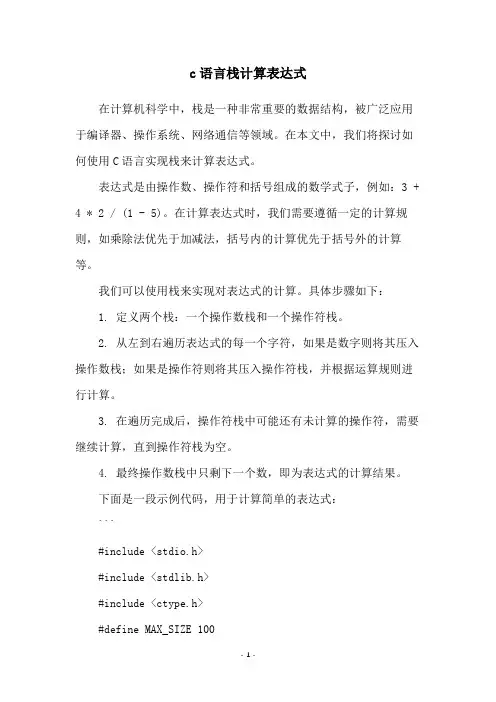
c语言栈计算表达式在计算机科学中,栈是一种非常重要的数据结构,被广泛应用于编译器、操作系统、网络通信等领域。
在本文中,我们将探讨如何使用C语言实现栈来计算表达式。
表达式是由操作数、操作符和括号组成的数学式子,例如:3 + 4 * 2 / (1 - 5)。
在计算表达式时,我们需要遵循一定的计算规则,如乘除法优先于加减法,括号内的计算优先于括号外的计算等。
我们可以使用栈来实现对表达式的计算。
具体步骤如下:1. 定义两个栈:一个操作数栈和一个操作符栈。
2. 从左到右遍历表达式的每一个字符,如果是数字则将其压入操作数栈;如果是操作符则将其压入操作符栈,并根据运算规则进行计算。
3. 在遍历完成后,操作符栈中可能还有未计算的操作符,需要继续计算,直到操作符栈为空。
4. 最终操作数栈中只剩下一个数,即为表达式的计算结果。
下面是一段示例代码,用于计算简单的表达式:```#include <stdio.h>#include <stdlib.h>#include <ctype.h>#define MAX_SIZE 100typedef struct {int data[MAX_SIZE];int top;} Stack;void initStack(Stack *s) {s->top = -1;}void push(Stack *s, int item) { if (s->top == MAX_SIZE - 1) { printf('Stack Overflow');exit(1);}s->data[++s->top] = item;}int pop(Stack *s) {if (s->top == -1) {printf('Stack Underflow');exit(1);}return s->data[s->top--];}int isEmpty(Stack *s) {return s->top == -1;}int isFull(Stack *s) {return s->top == MAX_SIZE - 1;}int peek(Stack *s) {return s->data[s->top];}int evaluate(char *expr) {Stack operandStack, operatorStack; initStack(&operandStack);initStack(&operatorStack);int i = 0;while (expr[i] != '0') {if (isdigit(expr[i])) {int num = 0;while (isdigit(expr[i])) {num = num * 10 + (expr[i] - '0'); i++;}push(&operandStack, num);}else if (expr[i] == '(') {push(&operatorStack, expr[i]);i++;}else if (expr[i] == ')') {while (!isEmpty(&operatorStack) && peek(&operatorStack) != '(') {int op2 = pop(&operandStack);int op1 = pop(&operandStack);char op = pop(&operatorStack);int result;switch (op) {case '+':result = op1 + op2;break;case '-':result = op1 - op2;break;case '*':result = op1 * op2;break;case '/':result = op1 / op2;break;}push(&operandStack, result);}pop(&operatorStack);i++;}else if (expr[i] == '+' || expr[i] == '-' || expr[i] == '*' || expr[i] == '/') {while (!isEmpty(&operatorStack) &&peek(&operatorStack) != '(' &&((expr[i] == '*' || expr[i] == '/') || (expr[i] == '+' || expr[i] == '-') &&(peek(&operatorStack) == '*' || peek(&operatorStack) == '/'))) {int op2 = pop(&operandStack);int op1 = pop(&operandStack);char op = pop(&operatorStack);int result;switch (op) {case '+':result = op1 + op2;break;case '-':result = op1 - op2;break;case '*':result = op1 * op2;break;case '/':result = op1 / op2;break;}push(&operandStack, result); }push(&operatorStack, expr[i]); i++;}else {i++;}}while (!isEmpty(&operatorStack)) { int op2 = pop(&operandStack);int op1 = pop(&operandStack);char op = pop(&operatorStack);int result;switch (op) {case '+':result = op1 + op2;break;case '-':result = op1 - op2;break;case '*':result = op1 * op2;break;case '/':result = op1 / op2;break;}push(&operandStack, result);}return pop(&operandStack);}int main() {char expr[MAX_SIZE];printf('Enter an expression: ');fgets(expr, MAX_SIZE, stdin);int result = evaluate(expr);printf('Result = %d', result);return 0;}```在这段代码中,我们定义了一个栈结构体,包含了栈的数据和栈顶指针。
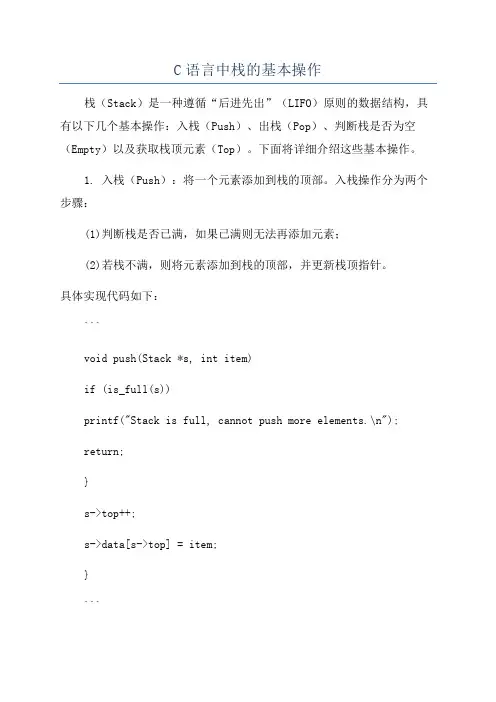
C语言中栈的基本操作栈(Stack)是一种遵循“后进先出”(LIFO)原则的数据结构,具有以下几个基本操作:入栈(Push)、出栈(Pop)、判断栈是否为空(Empty)以及获取栈顶元素(Top)。
下面将详细介绍这些基本操作。
1. 入栈(Push):将一个元素添加到栈的顶部。
入栈操作分为两个步骤:(1)判断栈是否已满,如果已满则无法再添加元素;(2)若栈不满,则将元素添加到栈的顶部,并更新栈顶指针。
具体实现代码如下:```void push(Stack *s, int item)if (is_full(s))printf("Stack is full, cannot push more elements.\n");return;}s->top++;s->data[s->top] = item;}```2. 出栈(Pop):将栈顶元素移除,并返回该元素的值。
出栈操作也有两个步骤:(1)判断栈是否为空,如果为空则无法进行出栈操作;(2)若栈不为空,则将栈顶元素移除,并更新栈顶指针。
具体实现代码如下:```int pop(Stack *s)int item;if (is_empty(s))printf("Stack is empty, cannot pop any elements.\n");return -1; // 指定一个特定的返回值来表示错误}item = s->data[s->top];s->top--;return item;}```3. 判断栈是否为空(Empty):判断栈是否为空分为两种情况,一种是根据栈顶指针进行判断,另一种是根据数据数量进行判断。
(1)判断栈顶指针是否为-1,若为-1则说明栈为空;(2)若栈内数据数量为0,则栈为空。
具体实现代码如下:```int is_empty(Stack *s)return s->top == -1; // 栈顶指针为-1表示栈为空}```4. 获取栈顶元素(Top):返回栈顶元素的值,但不对栈做任何修改。
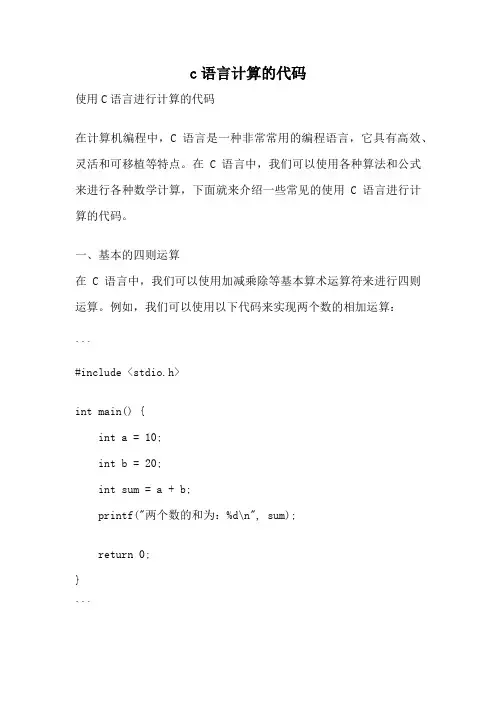
c语言计算的代码使用C语言进行计算的代码在计算机编程中,C语言是一种非常常用的编程语言,它具有高效、灵活和可移植等特点。
在C语言中,我们可以使用各种算法和公式来进行各种数学计算,下面就来介绍一些常见的使用C语言进行计算的代码。
一、基本的四则运算在C语言中,我们可以使用加减乘除等基本算术运算符来进行四则运算。
例如,我们可以使用以下代码来实现两个数的相加运算:```#include <stdio.h>int main() {int a = 10;int b = 20;int sum = a + b;printf("两个数的和为:%d\n", sum);return 0;}```二、求平方根在数学中,我们经常需要求一个数的平方根。
在C语言中,我们可以使用math.h头文件中的sqrt()函数来实现求平方根的功能。
下面是一个简单的例子:```#include <stdio.h>#include <math.h>int main() {double num = 16.0;double result = sqrt(num);printf("16的平方根为:%f\n", result);return 0;}```三、求阶乘阶乘是数学中常见的一个概念,表示从1到某个数之间所有整数的乘积。
在C语言中,我们可以使用循环结构来计算阶乘。
下面是一个计算阶乘的例子:```#include <stdio.h>int main() {int n = 5;int result = 1;for (int i = 1; i <= n; i++) {result *= i;}printf("5的阶乘为:%d\n", result);return 0;}```四、求最大公约数最大公约数是两个数中最大的能够同时整除两个数的数。
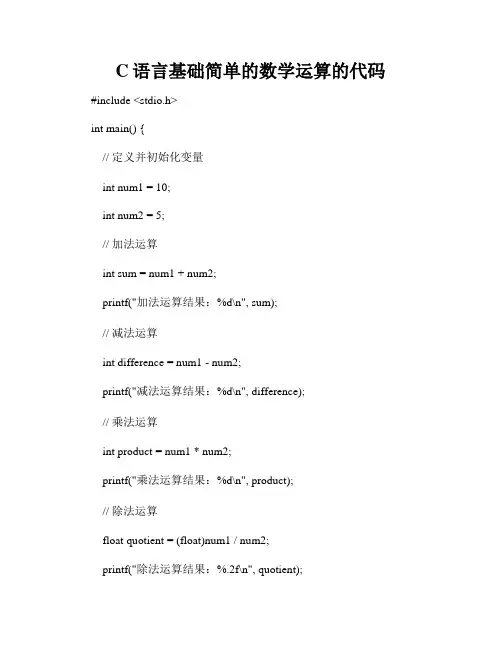
C语言基础简单的数学运算的代码#include <stdio.h>int main() {// 定义并初始化变量int num1 = 10;int num2 = 5;// 加法运算int sum = num1 + num2;printf("加法运算结果:%d\n", sum);// 减法运算int difference = num1 - num2;printf("减法运算结果:%d\n", difference);// 乘法运算int product = num1 * num2;printf("乘法运算结果:%d\n", product);// 除法运算float quotient = (float)num1 / num2;printf("除法运算结果:%.2f\n", quotient);// 求余运算int remainder = num1 % num2;printf("求余运算结果:%d\n", remainder);return 0;}以上是一个简单的C语言程序,实现了基本的数学运算功能。
程序运行后,会输出每个数学运算的结果。
接下来我会逐行解释代码的含义和执行过程。
首先,在程序的开头我们使用了#include <stdio.h>这行代码,这是为了包含C语言标准库中的输入输出函数,以便后续可以使用printf()函数打印结果。
接着,在main()函数中,我们定义并初始化了两个整型变量num1和num2,分别赋值为10和5。
这两个变量代表了我们要进行数学运算的两个操作数。
然后,我们使用加法运算将num1和num2相加得到sum,并使用printf()函数打印出加法运算的结果。
接着,我们使用减法运算将num1减去num2得到difference,并使用printf()函数打印出减法运算的结果。
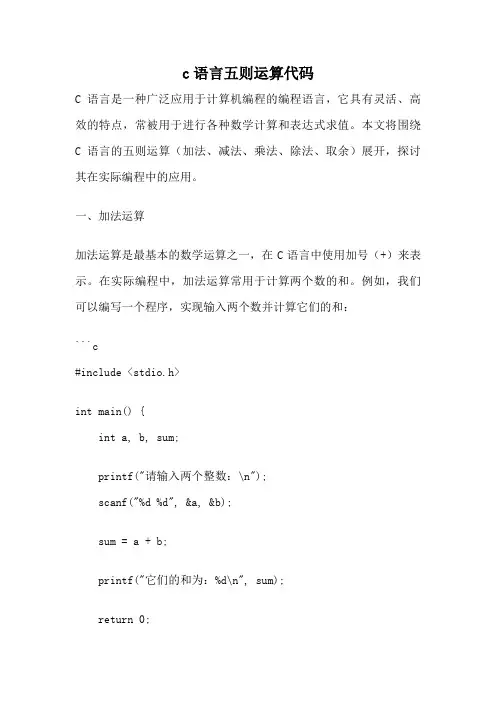
c语言五则运算代码C语言是一种广泛应用于计算机编程的编程语言,它具有灵活、高效的特点,常被用于进行各种数学计算和表达式求值。
本文将围绕C语言的五则运算(加法、减法、乘法、除法、取余)展开,探讨其在实际编程中的应用。
一、加法运算加法运算是最基本的数学运算之一,在C语言中使用加号(+)来表示。
在实际编程中,加法运算常用于计算两个数的和。
例如,我们可以编写一个程序,实现输入两个数并计算它们的和:```c#include <stdio.h>int main() {int a, b, sum;printf("请输入两个整数:\n");scanf("%d %d", &a, &b);sum = a + b;printf("它们的和为:%d\n", sum);return 0;}```二、减法运算减法运算是计算两个数之差的操作,在C语言中使用减号(-)来表示。
我们可以编写一个程序,实现输入两个数并计算它们的差:```c#include <stdio.h>int main() {int a, b, difference;printf("请输入两个整数:\n");scanf("%d %d", &a, &b);difference = a - b;printf("它们的差为:%d\n", difference);return 0;}```三、乘法运算乘法运算是计算两个数的积的操作,在C语言中使用星号(*)来表示。
我们可以编写一个程序,实现输入两个数并计算它们的积:```c#include <stdio.h>int main() {int a, b, product;printf("请输入两个整数:\n");scanf("%d %d", &a, &b);product = a * b;printf("它们的积为:%d\n", product);return 0;}```四、除法运算除法运算是计算两个数的商的操作,在C语言中使用斜杠(/)来表示。
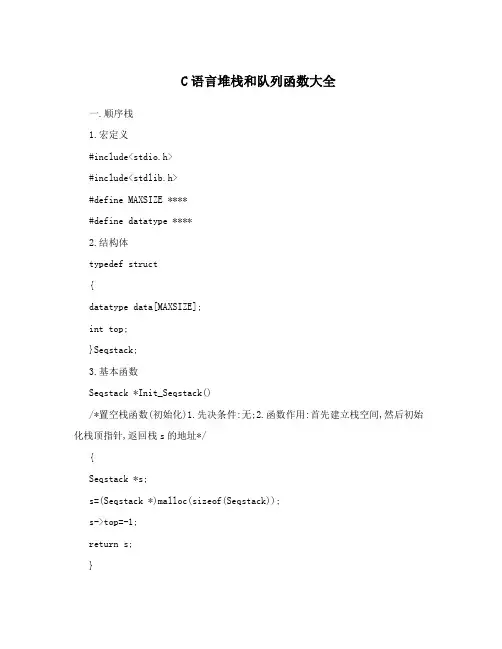
C语言堆栈和队列函数大全一.顺序栈1.宏定义#include<stdio.h>#include<stdlib.h>#define MAXSIZE ****#define datatype ****2.结构体typedef struct{datatype data[MAXSIZE];int top;}Seqstack;3.基本函数Seqstack *Init_Seqstack()/*置空栈函数(初始化)1.先决条件:无;2.函数作用:首先建立栈空间,然后初始化栈顶指针,返回栈s的地址*/{Seqstack *s;s=(Seqstack *)malloc(sizeof(Seqstack));s->top=-1;return s;}int Empty_Seqstack(Seqstack *s) /*判栈空函数1.先决条件:初始化顺序栈;2.函数作用:判断栈是否为空,空返回1,不空返回0*/ {if(s->top==-1) return 1;else return 0;}int Push_Seqstack(Seqstack *s,datatype x) /*入栈函数1.先决条件:初始化顺序栈2.函数作用:将数据x入栈,栈满则不能,成功返回1,因栈满失败返回0*/ {if(s->top==MAXSIZE-1)return 0;s->top=s->top+1;s->data[s->top]=x;return 1;}int Pop_Seqstack(Seqstack *s,datatype *x) acidity, mL.; M--calibration of the molar concentration of sodium hydroxide standard solution, moI/L; V--amount of the volume of sodium hydroxide standard solution, Ml; M--the weight of the sample, g. Such as poor meets the requirements, take the arithmetic mean of the second determination as a result. Results one decimal. 6, allowing differential analyst simultaneously or in quick succession for the second determination, the absolute value of the difference of the results. This value should be no more than 1.0. 1, definitions and principles for determination of ash in starches, starch and ash: starch samples of ash the residue obtainedafter weight. Original sample residue weight of sample weight or weight expressed as a percentage of the dry weight of the sample. Samples ofash at 900 ? high temperature until ashing sample ... The Crucible: determination of Platinum or other conditions of the affected material, capacity of 50mL. Dryer: has effectively adequate drying agent and-perforated metal plate or porcelain. Ashing furnaces: device for controlling and regulating temperature, offers 900 incineration temperature of 25 c. Analytical balance. Electric hot plate or Bunsen. 3, crucible of analysis steps preparation: Crucible must first wash with boiling dilute hydrochloric acid, then wash with a lot of water and then rinse with distilled water. Wash the Crucible within ashing furnace, heated at 900 to 25 ? 30min, and in the desiccator to cool to room temperature and then weighing,/*出栈函数1.先决条件:初始化顺序栈2.函数作用:从栈中出一个数据,并将其存放到x中,成功返回1,因栈空失败返回0*/{if(s->top==-1)return 0;*x=s->data[s->top];s->top--;return 1;}int Top_Seqstack(Seqstack *s,datatype *x)/*取栈顶元素函数1.先决条件:初始化顺序栈2.函数作用:取栈顶元素,并把其存放到x中,成功返回1,因栈空失败返回0*/{if(s->top==-1)return 0;*x=s->data[s->top];return 1;}int Printf_Seqstack(Seqstack *s) /*遍历顺序栈函数1.先决条件:初始化顺序栈2.函数作用:遍历顺序栈,成功返回1*/ {int i,j=0;for(i=s->top;i>=0;i--){printf("%d ",s->data[i]);/*因datatype不同而不同*/j++;if(j%10==0)printf("\n");}printf("\n");return 1;}int Conversation_Seqstack(int N,int r) /*数制转换函数(顺序栈)1.先决条件:具有置空栈,入栈,出栈函数2.函数作用:将N转换为r进制的数*/{Seqstack *s;datatype x;printf("%d转为%d进制的数为:",N,r);/*以后可以删除去*/s=Init_Seqstack();do{Push_Seqstack(s,N%r);N=N/r;acidity, mL.; M--calibration of the molar concentration of sodium hydroxide standard solution, moI/L; V--amount of the volume of sodium hydroxide standard solution, Ml; M--the weight of the sample, g. Such as poor meets the requirements, take the arithmetic mean of the second determination as a result. Results one decimal. 6, allowing differential analyst simultaneously or in quick succession for the second determination, the absolute value of the difference of the results. This value should be no more than 1.0. 1, definitions and principles for determination of ash in starches, starch and ash: starch samples of ash the residue obtained after weight. Original sample residue weight of sample weight or weight expressed as a percentage of the dry weight of the sample. Samples of ash at 900 ? high temperature until ashing sample ... The Crucible: determination of Platinum or other conditions of the affected material, capacity of 50mL. Dryer: has effectivelyadequate drying agent and-perforated metal plate or porcelain. Ashing furnaces: device for controlling and regulating temperature, offers 900 incineration temperature of 25 c. Analytical balance. Electric hot plate or Bunsen. 3, crucible of analysis steps preparation: Crucible mustfirst wash with boiling dilute hydrochloric acid, then wash with a lot of water and then rinse with distilled water. Wash the Crucible within ashing furnace, heated at 900 to 25 ? 30min, and in the desiccator to cool to room temperature and then weighing,}while(N);while(Pop_Seqstack(s,&x)){if(x>=10)/*为了能转为十进制以上的*/printf("%c",x+55);elseprintf("%d",x);}free(s);/*释放顺序栈*/printf("\n");return 1;}4.主函数int main(){Seqstack *s;int choice;datatype x;do{printf("************************************************************ ****\n");printf("1.置空栈 2.判栈空 3.入栈 4.出栈 5.取栈顶元素 6.遍历 7.退出\n");printf("************************************************************ ****\n");printf("请输入选择(1~7):");scanf("%d",&choice);getchar();switch(choice){case 1:s=Init_Seqstack();if(s)printf("置空栈成功!\n");break;case 2:if(Empty_Seqstack(s))printf("此为空栈.\n");elseprintf("此不为空栈.\n");;break;case 3:printf("请输入一个整数:");scanf("%d",&x);if(Push_Seqstack(s,x))printf("入栈成功.\n");elseprintf("栈已满,无法入栈.\n");;break;case 4:if(Pop_Seqstack(s,&x)) acidity, mL.; M--calibration of the molar concentration of sodium hydroxide standard solution, moI/L; V--amount of the volume of sodium hydroxide standard solution, Ml; M--the weight of the sample, g. Such as poor meets the requirements, take the arithmetic mean of the second determination as a result. Results one decimal. 6, allowing differential analyst simultaneously or in quick succession for the second determination, the absolute value of the difference of the results. This value should be no more than 1.0. 1, definitions and principles for determination of ash in starches, starch and ash: starch samples of ash the residue obtained after weight. Original sample residue weight of sample weight or weight expressed as a percentage of the dry weight of the sample. Samples of ash at 900 ? high temperature until ashing sample ... The Crucible: determination of Platinum or other conditions of the affected material, capacity of 50mL. Dryer: has effectively adequate drying agent and-perforated metal plate or porcelain. Ashing furnaces: device for controlling and regulating temperature, offers 900 incineration temperature of 25 c. Analytical balance. Electric hot plate or Bunsen. 3, crucible of analysis steps preparation: Crucible must first wash with boiling dilute hydrochloric acid, then wash with a lot of water and then rinse with distilled water.Wash the Crucible within ashing furnace, heated at 900 to 25 ? 30min, and in the desiccator to cool to room temperature and then weighing, printf("出栈成功,出栈元素为:%d\n",x);elseprintf("出栈失败,因栈为空.\n");break;case 5:if(Top_Seqstack(s,&x))printf("取栈顶元素成功,栈顶元素为:%d\n",x);elseprintf("取栈顶元素失败,因栈为空.\n");break;case 6:Printf_Seqstack(s);break;case 7:printf("谢谢使用!\n");break;default :printf("输入错误,请重新输入!\n");break;}}while(choice!=7);return 0;}二.链栈1.宏定义#include<stdio.h>#include<stdlib.h>#define datatype ****2.结构体typedef struct snode{datatype data;struct snode *next;}Stacknode,*Linkstack;3.基本函数Linkstack Init_Linkstack()/*初始化栈函数1.先决条件:无2.函数作用:初始化链栈,返回top地址*/ { Linkstack top;top=(Linkstack)malloc(sizeof(Stacknode));top->next=NULL;return top;}int Empty_Linkstack(Linkstack top) /*判栈空函数1.先决条件:初始化链栈2.函数作用:判断栈是否为空,空返回1,不空返回0*/{if(top->next==NULL)acidity, mL.; M--calibration of the molar concentration of sodium hydroxide standard solution, moI/L; V--amount of the volume of sodium hydroxide standard solution, Ml; M--the weight of the sample, g. Such as poor meets the requirements, take the arithmetic mean of the second determination as a result. Results one decimal. 6, allowing differential analyst simultaneously or in quick succession for the second determination, the absolute value of the difference of the results. This value should be no more than 1.0. 1, definitions and principles fordetermination of ash in starches, starch and ash: starch samples of ash the residue obtained after weight. Original sample residue weight of sample weight or weight expressed as a percentage of the dry weight of the sample. Samples of ash at 900 ? high temperature until ashing sample ... The Crucible: determination of Platinum or other conditions of the affected material, capacity of 50mL. Dryer: has effectively adequate drying agent and-perforated metal plate or porcelain. Ashing furnaces: device for controlling and regulating temperature, offers 900 incineration temperature of 25 c. Analytical balance. Electric hot plate or Bunsen. 3, crucible of analysis steps preparation: Crucible mustfirst wash with boiling dilute hydrochloric acid, then wash with a lot of water and then rinse with distilled water. Wash the Crucible within ashing furnace, heated at 900 to 25 ? 30min, and in the desiccator to cool to room temperature and then weighing,return 1;else return 0;}int Push_Linkstack(Linkstack top,datatype x) /*入栈函数1.先决条件:初始化链栈2.函数作用:将数据x入栈,成功返回1,失败返回0*/ { Stacknode *p;p=(Stacknode *)malloc(sizeof(Stacknode));p->data=x;p->next=top->next;top->next=p;return 1;}int Pop_Linkstack(Linkstack top,datatype *x) /*出栈函数1.先决条件:初始化链栈2.函数作用:若栈空退出,若没空则将数据出栈,并将其存放到x中,成功返回1,因栈空失败返回0*/{if(top->next==NULL)return 0;Stacknode *p=top->next;*x=p->data;top->next=p->next;free(p);return 1;}int Top_Linkstack(Linkstack top,datatype *x) /*取栈顶元素函数1.先决条件:初始化链栈2.函数作用:取栈顶元素并放到x中,成功返回1,因栈空失败返回0*/{if(top->next==NULL)return 0;*x=top->next->data;return 1;}int Printf_Linkstack(Linkstack top) /*遍历链栈函数1.先决条件:初始化链栈2.函数作用:遍历链栈,成功返回1*/ {Stacknode *p=top->next;int j=0;while(p){printf("%d ",p->data);/*因datatype不同而不同*/j++;if(j%10==0)acidity, mL.; M--calibration of the molar concentration of sodium hydroxide standard solution, moI/L; V--amount of the volume of sodium hydroxide standard solution, Ml; M--the weight of the sample, g. Such as poor meets the requirements, take the arithmetic mean of the second determination as a result. Results one decimal. 6, allowing differential analyst simultaneously or in quick succession for the second determination, the absolute value of the difference of the results. This value should be no more than 1.0. 1, definitions and principles for determination of ash in starches, starch and ash: starch samples of ash the residue obtained after weight. Original sample residue weight of sample weight or weight expressed as a percentage of the dry weight of the sample. Samples of ash at 900 ? high temperature until ashing sample ... The Crucible: determination of Platinum or other conditions of the affected material, capacity of 50mL. Dryer: has effectively adequate drying agent and-perforated metal plate or porcelain. Ashingfurnaces: device for controlling and regulating temperature, offers 900 incineration temperature of 25 c. Analytical balance. Electric hot plate or Bunsen. 3, crucible of analysis steps preparation: Crucible mustfirst wash with boiling dilute hydrochloric acid, then wash with a lot of water and then rinse with distilled water. Wash the Crucible within ashing furnace, heated at 900 to 25 ? 30min, and in the desiccator to cool to room temperature and then weighing,printf("\n");p=p->next;}printf("\n");return 1;}int Conversation_Linkstack(int N,int r)/*数制转换函数(链栈)1.先决条件:具有置空栈,入栈,出栈函数2.函数作用:将N转换为r进制的数*/{Linkstack top;datatype x;printf("%d转为%d进制的数为:",N,r);/*以后可以删除去*/top=Init_Linkstack();do{Push_Linkstack(top,N%r);N=N/r;}while(N);while(Pop_Linkstack(top,&x)){if(x>=10)/*为了能转为十进制以上的*/printf("%c",x+55);elseprintf("%d",x);}printf("\n");free(top);/*释放栈顶空间*/return 1;}4.主函数int main(){Linkstack top;int choice;datatype x;do{printf("************************************************************ ****\n");printf("1.置空栈 2.判栈空 3.入栈 4.出栈 5.取栈顶元素 6.遍历 7.退出\n");printf("************************************************************ ****\n");printf("请输入选择(1~7):");acidity, mL.; M--calibration of the molar concentration of sodium hydroxide standard solution, moI/L; V--amount of the volume of sodium hydroxide standard solution, Ml; M--the weight of the sample, g. Such as poor meets the requirements, take the arithmetic mean of the second determination as a result. Results one decimal. 6, allowing differential analyst simultaneously or in quick succession for the second determination, the absolute value of the difference of the results. This value should be no more than 1.0. 1, definitions and principles for determination of ash in starches, starch and ash: starch samples of ash the residue obtained after weight. Original sample residue weight of sample weight or weight expressed as a percentage of the dry weight of the sample. Samples of ash at 900 ? high temperature until ashing sample ... The Crucible: determination of Platinum or other conditions of the affected material, capacity of 50mL. Dryer: has effectively adequate drying agent and-perforated metal plate or porcelain. Ashing furnaces: device for controlling and regulating temperature, offers 900 incineration temperature of 25 c. Analytical balance. Electric hot plate or Bunsen. 3, crucible of analysis steps preparation: Crucible mustfirst wash with boiling dilute hydrochloric acid, then wash with a lotof water and then rinse with distilled water. Wash the Crucible within ashing furnace, heated at 900 to 25 ? 30min, and in the desiccator to cool to room temperature and then weighing,scanf("%d",&choice);getchar();switch(choice){case 1:top=Init_Linkstack();if(top)printf("置空栈成功!\n");break;case 2:if(Empty_Linkstack(top))printf("此为空栈.\n");elseprintf("此不为空栈.\n");;break;case 3:printf("请输入一个整数:");scanf("%d",&x);if(Push_Linkstack(top,x))printf("入栈成功.\n");elseprintf("栈已满,无法入栈.\n");;break;case 4:if(Pop_Linkstack(top,&x))printf("出栈成功,出栈元素为:%d\n",x);elseprintf("出栈失败,因栈为空.\n");break;case 5:if(Top_Linkstack(top,&x))printf("取栈顶元素成功,栈顶元素为:%d\n",x);elseprintf("取栈顶元素失败,因栈为空.\n");break;case 6:Printf_Linkstack(top);break;case 7:printf("谢谢使用!\n");break;default :printf("输入错误,请重新输入!\n");break;}}while(choice!=7);return 0;}二.队列1.宏定义2.结构体3.基本函数4.主函数acidity, mL.; M--calibration of the molar concentration of sodium hydroxide standard solution, moI/L; V--amount of the volume of sodium hydroxide standard solution, Ml; M--the weight of the sample, g. Such as poor meets the requirements, take the arithmetic mean of the second determination as a result. Results one decimal. 6, allowing differential analyst simultaneously or in quick succession for the second determination, the absolute value of the difference of the results. Thisvalue should be no more than 1.0. 1, definitions and principles for determination of ash in starches, starch and ash: starch samples of ash the residue obtained after weight. Original sample residue weight of sample weight or weight expressed as a percentage of the dry weight of the sample. Samples of ash at 900 ? high temperature until ashing sample ... The Crucible: determination of Platinum or other conditions of the affected material, capacity of 50mL. Dryer: has effectively adequate drying agent and-perforated metal plate or porcelain. Ashing furnaces: device for controlling and regulating temperature, offers 900 incineration temperature of 25 c. Analytical balance. Electric hot plate or Bunsen. 3, crucible of analysis steps preparation: Crucible mustfirst wash with boiling dilute hydrochloric acid, then wash with a lot of water and then rinse with distilled water. Wash the Crucible within ashing furnace, heated at 900 to 25 ? 30min, and in the desiccator to cool to room temperature and then weighing,。
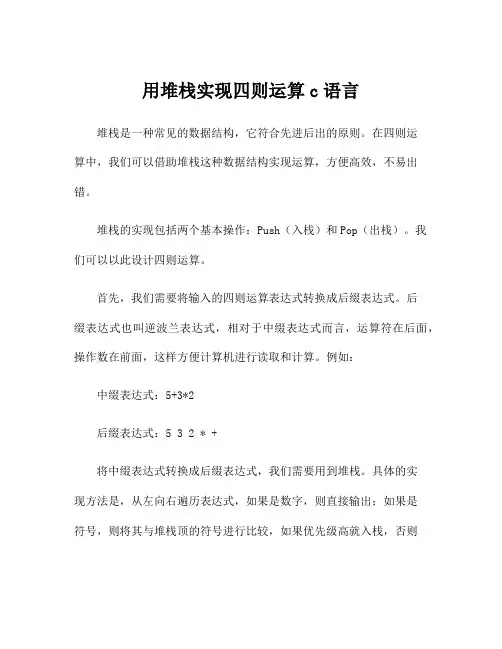
用堆栈实现四则运算c语言堆栈是一种常见的数据结构,它符合先进后出的原则。
在四则运算中,我们可以借助堆栈这种数据结构实现运算,方便高效,不易出错。
堆栈的实现包括两个基本操作:Push(入栈)和Pop(出栈)。
我们可以以此设计四则运算。
首先,我们需要将输入的四则运算表达式转换成后缀表达式。
后缀表达式也叫逆波兰表达式,相对于中缀表达式而言,运算符在后面,操作数在前面,这样方便计算机进行读取和计算。
例如:中缀表达式:5+3*2后缀表达式:5 3 2 * +将中缀表达式转换成后缀表达式,我们需要用到堆栈。
具体的实现方法是,从左向右遍历表达式,如果是数字,则直接输出;如果是符号,则将其与堆栈顶的符号进行比较,如果优先级高就入栈,否则不断将符号出栈并输出,直到当前符号优先级大于堆栈顶符号优先级,最后将当前符号入栈。
例如:表达式:5+3*2堆栈操作:1.将5输出,堆栈为空2.遇到+号,入栈3.将3输出,堆栈顶为+号4.遇到*号,入栈5.将2输出,堆栈顶为*号6.输出*号,堆栈顶为+号7.输出+号,堆栈为空得到后缀表达式:5 3 2 * +有了后缀表达式,我们可以用堆栈进行计算。
具体方法是,从左向右遍历后缀表达式,如果是数字则入栈,如果是符号则将栈顶两个数字出栈并进行计算,将结果入栈,最终得到最终的计算结果。
例如:后缀表达式:5 3 2 * +堆栈操作:1.将5入栈2.将3入栈3.遇到*号,出栈3和2,进行计算得到6,将6入栈4.将栈顶元素5出栈5.遇到+号,出栈6和5,进行计算得到11,将11入栈得到计算结果:11通过堆栈实现四则运算,可以有效简化我们的计算流程,避免复杂的优先级判断和计算错误。
同时,堆栈为我们提供了一种更加高效的数据结构,不仅在四则运算中可以发挥作用,在其他应用中也很常见。
当然,在实际应用中,我们需要考虑到多种情况的处理,例如负数、小数、括号等,以及错误处理等细节问题,才能保证算法的正确性和可靠性。
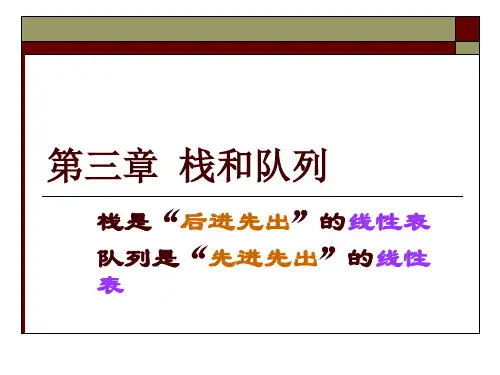
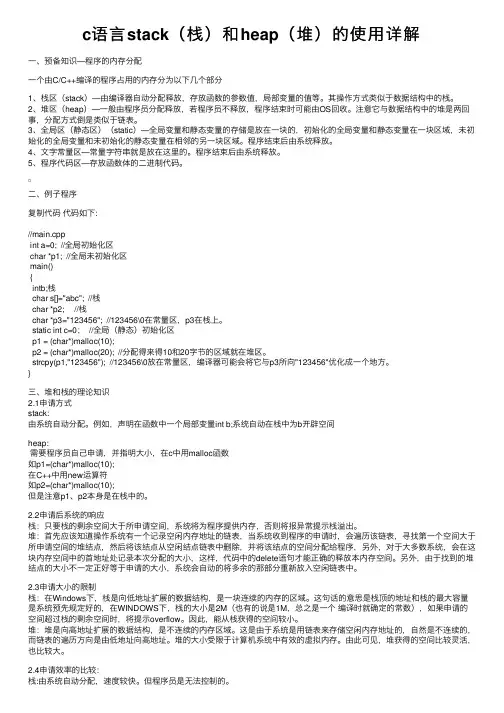
c语⾔stack(栈)和heap(堆)的使⽤详解⼀、预备知识—程序的内存分配⼀个由C/C++编译的程序占⽤的内存分为以下⼏个部分1、栈区(stack)—由编译器⾃动分配释放,存放函数的参数值,局部变量的值等。
其操作⽅式类似于数据结构中的栈。
2、堆区(heap)—⼀般由程序员分配释放,若程序员不释放,程序结束时可能由OS回收。
注意它与数据结构中的堆是两回事,分配⽅式倒是类似于链表。
3、全局区(静态区)(static)—全局变量和静态变量的存储是放在⼀块的,初始化的全局变量和静态变量在⼀块区域,未初始化的全局变量和未初始化的静态变量在相邻的另⼀块区域。
程序结束后由系统释放。
4、⽂字常量区—常量字符串就是放在这⾥的。
程序结束后由系统释放。
5、程序代码区—存放函数体的⼆进制代码。
⼆、例⼦程序复制代码代码如下://main.cppint a=0; //全局初始化区char *p1; //全局未初始化区main(){intb;栈char s[]="abc"; //栈char *p2; //栈char *p3="123456"; //123456\0在常量区,p3在栈上。
static int c=0; //全局(静态)初始化区p1 = (char*)malloc(10);p2 = (char*)malloc(20); //分配得来得10和20字节的区域就在堆区。
strcpy(p1,"123456"); //123456\0放在常量区,编译器可能会将它与p3所向"123456"优化成⼀个地⽅。
}三、堆和栈的理论知识2.1申请⽅式stack:由系统⾃动分配。
例如,声明在函数中⼀个局部变量int b;系统⾃动在栈中为b开辟空间heap:需要程序员⾃⼰申请,并指明⼤⼩,在c中⽤malloc函数如p1=(char*)malloc(10);在C++中⽤new运算符如p2=(char*)malloc(10);但是注意p1、p2本⾝是在栈中的。
C语言简单计算器实现四则运算可带括号```c#include <stdio.h>#include <stdlib.h>int priority(char op)if (op == '+' , op == '-')return 1;else if (op == '*' , op == '/')return 2;else if (op == '(')return 0;elsereturn -1;void calculate(char op, int *numStack, int *top, char *opStack, int *opTop)int num2 = numStack[(*top)--];int num1 = numStack[(*top)--];switch (op)case '+':numStack[++(*top)] = num1 + num2; break;case '-':numStack[++(*top)] = num1 - num2; break;case '*':numStack[++(*top)] = num1 * num2; break;case '/':numStack[++(*top)] = num1 / num2; break;}int eval(char *expr)int numStack[100];char opStack[100];int numTop = -1;int opTop = -1;int num = 0;int sign = 1;while (*expr != '\0')if (*expr >= '0' && *expr <= '9')num = num * 10 + (*expr - '0');} else if (*expr == '+' , *expr == '-')numStack[++numTop] = num * sign;num = 0;sign = (*expr == '+') ? 1 : -1;} else if (*expr == '*' , *expr == '/')while (opTop >= 0 && priority(*expr) <=priority(opStack[opTop]))calculate(opStack[opTop--], numStack, &numTop, opStack, &opTop);}opStack[++opTop] = *expr;} else if (*expr == '(')opStack[++opTop] = '(';} else if (*expr == ')')while (opStack[opTop] != '(')calculate(opStack[opTop--], numStack, &numTop, opStack, &opTop);}opTop--;}expr++;}numStack[++numTop] = num * sign;while (opTop >= 0)calculate(opStack[opTop--], numStack, &numTop, opStack, &opTop);}return numStack[0];int maichar expr[100];printf("请输入表达式:");scanf("%s", expr);int result = eval(expr);printf("计算结果:%d\n", result);return 0;```以上是一个简单的C语言四则运算计算器的实现。
栈是一种常见的数据结构,用于解决许多算法和数据处理问题。
在编程中,栈通常用于处理表达式求值问题。
本篇文章将介绍如何使用栈解决表达式求值问题,并给出对应的C语言代码。
1. 表达式求值问题介绍表达式求值是指计算一个数学表达式的值,通常涉及到四则运算、括号和优先级等概念。
给定一个表达式“3 + 4 * 2”,我们需要得到其计算结果为11。
在编程中,需要将该表达式转换为计算机可识别的形式,并使用算法进行求值。
2. 中缀表达式、前缀表达式和后缀表达式在计算机中常见的表达式有三种形式:中缀表达式、前缀表达式和后缀表达式。
其中,中缀表达式是通常人们在日常生活中使用的表达式形式,如“3 + 4 * 2”。
前缀表达式是运算符位于操作数之前的形式,例如“+ 3 * 4 2”。
后缀表达式则是运算符位于操作数之后的形式,例如“3 4 2 * +”。
3. 使用栈解决表达式求值问题在解决表达式求值问题时,我们可以利用栈的特性来简化计算过程。
具体步骤如下:3.1 将中缀表达式转换为后缀表达式我们需要将中缀表达式转换为后缀表达式,这样可以简化表达式的计算顺序。
具体转换规则如下:- 从左至右扫描中缀表达式的每个数字或符号。
- 如果是操作数,则直接输出。
- 如果是运算符,则弹出栈中所有优先级大于或等于该运算符的运算符,并将其压入栈中,然后压入该运算符。
- 如果是括号,则根据括号的不同情况进行处理。
通过以上规则,我们可以将中缀表达式转换为后缀表达式。
3.2 计算后缀表达式的值得到后缀表达式后,我们可以利用栈来计算其值。
具体步骤如下:- 从左至右扫描后缀表达式的每个数字或符号。
- 如果是操作数,则压入栈中。
- 如果是运算符,则弹出栈中的两个操作数进行相应的运算,并将结果压入栈中。
- 继续扫描直到表达式结束,栈中的值即为所求结果。
通过以上步骤,我们可以使用栈来解决表达式求值问题。
4. C语言代码实现以下是使用C语言实现栈来解决表达式求值问题的代码示例:```c#include <stdio.h>#include <stdlib.h>#include <string.h>typedef struct {int top;int capacity;int* array;} Stack;Stack* createStack(int capacity) {Stack* stack = (Stack*)malloc(sizeof(Stack));stack->capacity = capacity;stack->top = -1;stack->array = (int*)malloc(stack->capacity * sizeof(int)); return stack;}int isFull(Stack* stack) {return stack->top == stack->capacity - 1; }int isEmpty(Stack* stack) {return stack->top == -1;}void push(Stack* stack, int item) {if (isFull(stack)) return;stack->array[++stack->top] = item;}int pop(Stack* stack) {if (isEmpty(stack)) return -1;return stack->array[stack->top--];}int evaluatePostfix(char* exp) {Stack* stack = createStack(strlen(exp)); for (int i = 0; exp[i]; i++) {if (isdigit(exp[i])) {push(stack, exp[i] - '0');} else {int val1 = pop(stack);int val2 = pop(stack);switch (exp[i]) {case '+':push(stack, val2 + val1); break;case '-':push(stack, val2 - val1); break;case '*':push(stack, val2 * val1); break;case '/':push(stack, val2 / val1); break;}}}return pop(stack);}int m本人n() {char exp[] = "34*2+";printf("The value of s is d\n", exp, evaluatePostfix(exp));return 0;}```以上代码实现了栈的基本功能,并利用栈来计算后缀表达式的值。
C语言数据结构之栈的基本操作栈是一种特殊的数据结构,它按照后进先出(LIFO)的原则进行操作。
栈可以用数组或链表来实现,下面将介绍栈的基本操作。
1.初始化栈:栈的初始化就是为栈分配内存空间,并将栈顶指针设置为-1(如果是数组实现)或者NULL(如果是链表实现)。
2.判断栈空:栈空表示栈中没有任何元素。
如果栈顶指针等于-1或者NULL,则表示栈空。
3.判断栈满:栈满表示栈中已经存满了元素。
如果栈顶指针等于栈的最大容量减1,则表示栈满。
4. 进栈(push):进栈操作就是将元素放入栈中。
如果栈不满,则将栈顶指针加1,并将元素放入栈顶位置。
5. 出栈(pop):出栈操作就是从栈中取出一个元素。
如果栈不空,则将栈顶指针减1,并返回栈顶元素。
6. 获取栈顶元素(getTop):获取栈顶元素操作不改变栈的状态,只返回栈顶元素的值。
如果栈不空,则返回栈顶元素值;否则,返回空值。
7.清空栈:清空栈操作就是将栈中的所有元素全部出栈,即将栈顶指针设置为-1或者NULL。
8.销毁栈:销毁栈操作是释放栈的内存空间,将栈的指针设置为NULL。
栈的应用:栈在计算机领域有广泛的应用,其中一个常见的应用是函数调用栈。
当一个函数调用另一个函数时,当前函数的状态(包括局部变量、返回地址等)会被压入到栈中。
当被调用函数执行完成后,栈顶的元素会被弹出,然后继续执行调用该函数的代码。
另一个常见的应用是表达式求值。
在表达式求值过程中,需要用到运算符优先级。
我们可以利用栈来处理运算符的优先级。
将运算符入栈时,可以先与栈顶运算符比较优先级,如果栈顶运算符的优先级高于当前运算符,则将栈顶运算符出栈,并继续比较。
这样可以确保栈中的运算符按照优先级从高到低的顺序排列。
此外,栈还可以用于处理括号匹配问题。
当遇到左括号时,将其入栈;当遇到右括号时,判断栈顶元素是否为对应的左括号,如果是,则将栈顶元素弹出,否则表示括号不匹配。
如果最后栈为空,则表示所有括号都匹配。
栈是一种后进先出(LIFO)的数据结构,在C语言中通常使用数组或链表来实现。
以下是一些关于栈的C语言题目:
1. 栈的定义和基本操作:定义一个栈数据结构,实现推入(push)、弹出(pop)、查看栈顶(peek)等基本操作。
2. 栈的应用:使用栈解决括号匹配问题,例如给定一个只包含'('、')'、'{'、'}'、'['、']'的字符串,判断字符串是否有效。
3. 逆波兰表达式求值:给定一个逆波兰表达式,利用栈计算表达式的值。
4. 浏览器前进后退功能的模拟:使用两个栈来模拟浏览器的前进和后退功能。
5. 最小值栈:设计一个栈,除了正常的push/pop操作外,还支持查询当前栈中的最小元素。
6. 有效的括号序列:给定一个只包含'('、')'、'{'、'}'、'['、']'的字符串,判断字符串是否为有效的括号序列。
7. 用栈实现队列:仅使用栈来实现队列的操作,如enqueue、dequeue等。
8. 括号的最大嵌套深度:给定一个只包含'('、')'、'{'、'}'、'['、']'的字符串,求出合法括号序列的最大嵌套深度。
9. 逆序对问题:给定一个数组,找出所有逆序对。
10. 汉诺塔问题:使用栈来解决经典的汉诺塔问题。
c语言求解带括号的四则运算表达式如何用C语言求解带括号的四则运算表达式在C语言中,我们可以使用栈来求解带括号的四则运算表达式。
栈是一种先入后出(Last-In-First-Out)的数据结构,对于表达式中的每一个运算符,我们都可以使用栈来保存其优先级。
下面是一步一步的解决方法。
第一步:定义运算符优先级在处理表达式时,我们需要知道每个运算符的优先级。
在C语言中,可以使用switch语句来定义每个运算符的优先级。
例如:cint getPriority(char op) {switch(op) {case '+':case '-':return 1;case '*':case '/':return 2;case '(':case ')':default:return 0;}}在这个函数中,我们将运算符+和-的优先级定义为1,将运算符*和/的优先级定义为2,而括号的优先级定义为0。
第二步:将表达式转换为后缀表达式后缀表达式是指将运算符放在操作数之后的表达式形式。
为了求解带括号的四则运算表达式,我们首先需要将其转换为后缀表达式。
具体的转换规则如下:1. 从左到右扫描表达式,如果遇到操作数,则直接将其输出。
2. 如果遇到运算符,则将其与栈顶的运算符比较优先级。
如果栈顶的运算符优先级大于等于当前的运算符,则将栈顶的运算符弹出并输出,直到栈顶的运算符优先级小于当前的运算符或者栈为空。
然后将当前的运算符压入栈中。
3. 如果遇到左括号,则直接将其压入栈中。
4. 如果遇到右括号,则将栈顶的运算符弹出并输出,直到遇到左括号为止。
左括号不输出。
例如,对于表达式"3 + 4 * ( 2 - 1 )",其转换为后缀表达式为"3 4 2 1 - * +"。
第三步:求解后缀表达式在将表达式转换为后缀表达式之后,我们可以使用栈来求解后缀表达式。
c语言栈的定义摘要:1.栈的概述2.C 语言栈的定义与实现3.栈的基本操作4.栈的应用实例正文:【栈的概述】栈是一种线性数据结构,它按照后进先出(Last In First Out, LIFO)的原则组织数据。
栈可以用来存储程序运行过程中产生的中间结果,或者用于函数调用、表达式求值等场景。
栈在计算机科学中具有广泛的应用,如编译原理、操作系统等。
【C 语言栈的定义与实现】C 语言中,栈可以通过数组或链表来实现。
栈的定义通常包括两个部分:栈顶指针(top)和栈的大小(size)。
栈顶指针用于指向栈顶元素,而栈的大小表示栈可以容纳的元素个数。
【栈的基本操作】栈的基本操作包括:入栈(push)、出栈(pop)、查看栈顶元素(top)和判断栈是否为空(is_empty)。
1.入栈:将一个元素放入栈顶。
2.出栈:弹出栈顶元素。
3.查看栈顶元素:获取栈顶元素的值,但不将其弹出。
4.判断栈是否为空:检查栈中是否还有元素。
【栈的应用实例】栈在程序设计中有很多应用,下面以计算表达式值为例,展示栈如何用于表达式求值。
假设有一个表达式:a + b * c,我们需要计算该表达式的值。
首先,我们需要将表达式中的每个操作数和运算符入栈。
然后,按照栈的出栈顺序,进行运算。
具体过程如下:1.将"a" 入栈。
2.将"+" 入栈。
3.将"b" 入栈。
4.将"*" 入栈。
5.将"c" 入栈。
6.弹出栈顶元素"+",进行加法运算,结果入栈。
7.弹出栈顶元素"b",进行乘法运算,结果入栈。
8.弹出栈顶元素"c",进行乘法运算,结果入栈。
9.弹出栈顶元素,得到表达式的值:a + b * c。
【结语】栈作为一种重要的数据结构,在C 语言编程中具有广泛的应用。